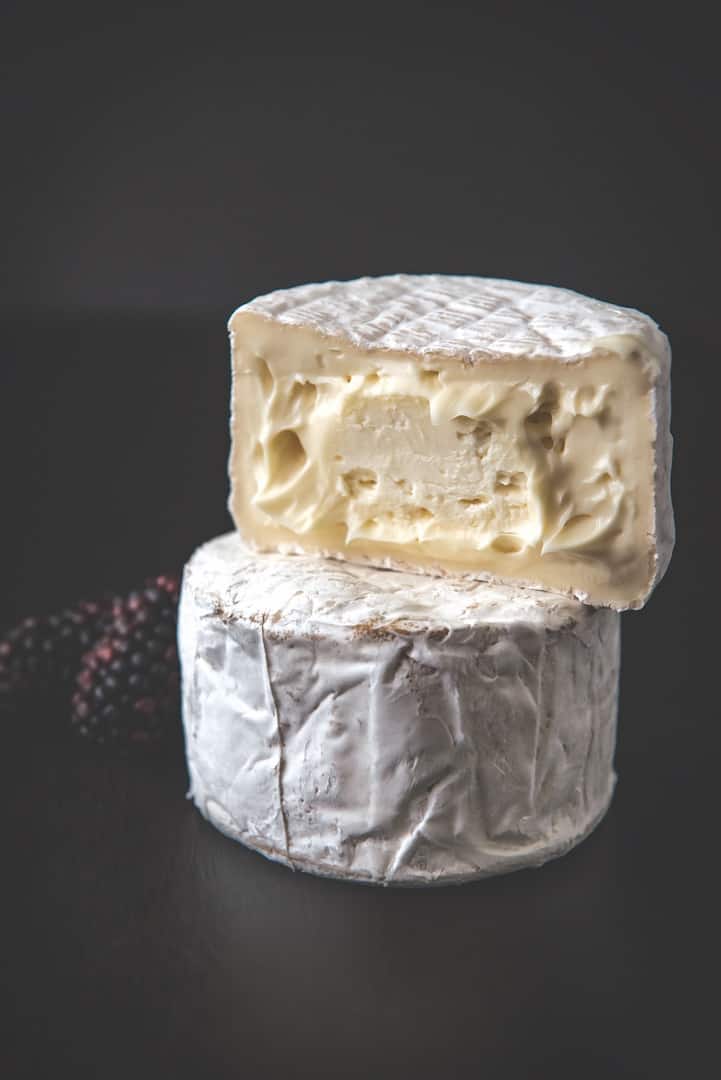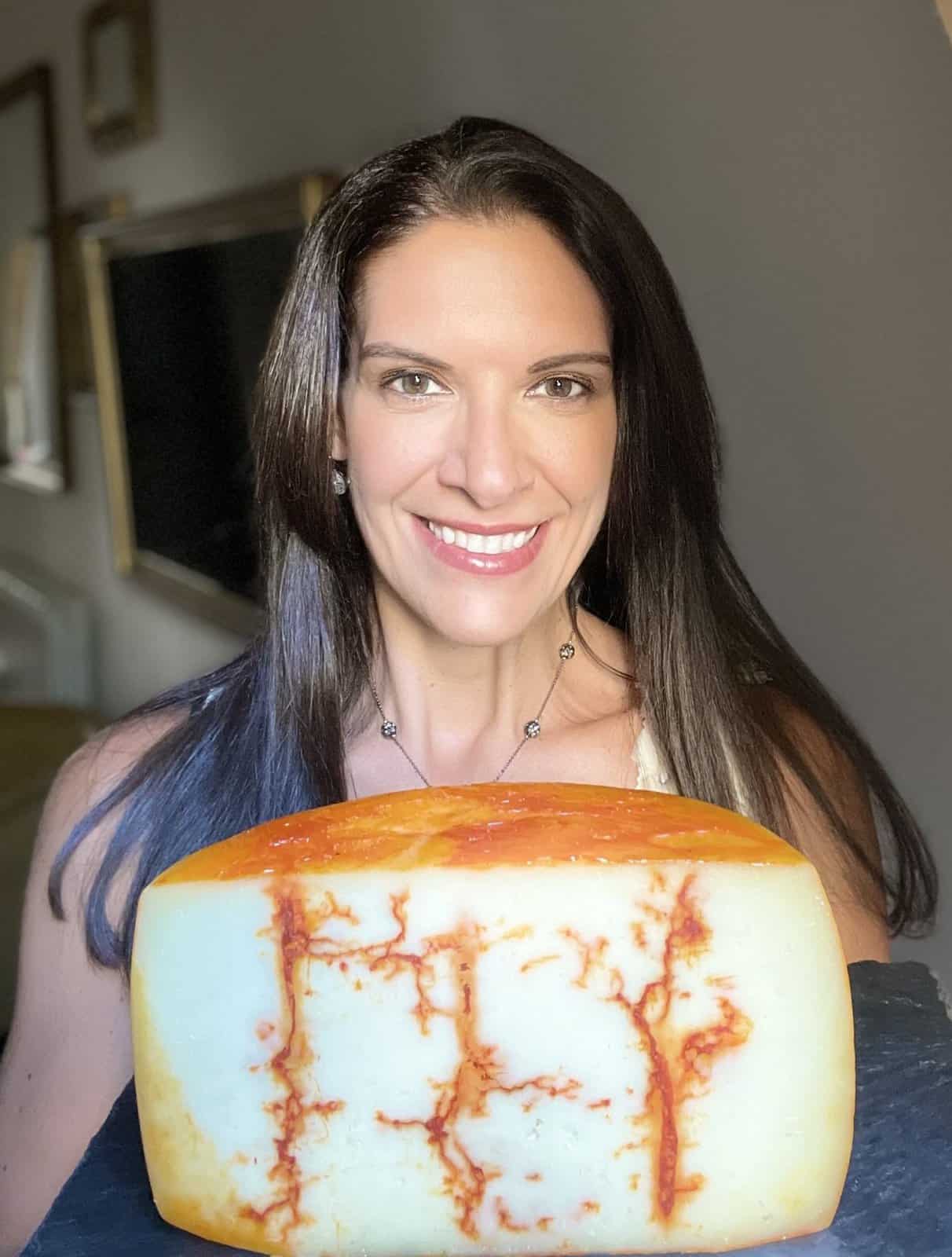
Long before the term “food porn” was coined, the pairing of two other words evoked images of decadence and hedonism in the minds of cheese lovers: triple crème (or “triple cream,” as it’s typically referred to stateside). This style of fromage originated in 19th-century France, when lush rounds made from cow’s milk with added cream became a symbol of opulence and a literal taste of luxury.
“To understand triple creams, one must go back to the past, when being a ‘fat’ person was a visible sign of wealth,” says Lyon-based cheesemonger François Robin. The earliest cream-enriched cheeses, such as Excelsior—the precursor to classic Brillat-Savarin—were touted for their high percentage of matière grasse (“fat content”)—a marketing strategy that seems counterintuitive in contemporary times. After the lean years of World War II, there was a resurgence in the popularity of triple creams, with wheels like Explorateur and Lucullus valued for their silky texture, indulgent mouthfeel and buttery flavor.
In more recent history, American makers have developed New World–style triple cream cheeses that rival their French predecessors. A groundbreaking moment came in 2005, when California’s Marin French Cheese won a gold medal at the prestigious World Cheese Awards in London for its Triple Crème Brie. The “international incident,” as described by Florence Fabricant in The New York Times, marked the first time an American producer took top honors in the bloomy rind category. It was compared to the historic 1976 Judgment of Paris, when two Napa Valley wines beat France’s best in a blind tasting.
“All the French rules were broken. But our cheese was good,” says Amelie Curis, operations director at Marin French Cheese.
What’s in a Name?
In France, the use of the terms “double crème” and “triple crème” on labels is protected by law. Achieved with the addition of cream to the milk before coagulation, the former must contain 60 percent to 75 percent fat, while the latter is obliged to carry a minimum of 75 percent. But these figures can be misleading—they refer to fat in dry matter, the fat present in the solids that would remain if all of the moisture was removed from the cheese. The total fat content in the final product for a serving of Brillat-Savarin, for example, is about 38 percent.
While measuring fat in this way might seem unnecessarily complicated, it accounts for the decrease in moisture content that occurs as cheese ages, thereby providing a consistent standard to enforce regulations. Lauren Toth, project manager of training and curriculum at Murray’s Cheese, equates this process to making apple chips—if you dehydrated a piece of triple cream cheese in similar fashion, you wouldn’t be left with much solid matter. “These gooier soft-ripened cheeses are made with a significant amount of moisture, as opposed to something dry and firm [with] very little water left in it at all,” she points out. Indeed, Brillat-Savarin’s overall fat content of 38 percent is similar to that in an equal-size serving of Parmigiano Reggiano, which typically hovers around 30 percent.
American triple cream makers tend to abide by the French conventions, but they aren’t subject to the same legal regulations—and while the addition of cream to the milk is a constant, the quantity varies among producers. This results in a broader range of fat content: Coach Farm Triple Cream, for example, boasts an overall fat content upward of 50 percent, while Marin French Cheese Triple Crème Brie contains only 29 percent fat. In the latter case, enough cream is added during cheesemaking to triple the quantity of fat in the milk, but the end result is actually lower in fat than most other triple creams because the original recipe was based on 2 percent instead of whole milk. “We didn’t want to change the recipe to fit with the French rules,” explains Amelie Curis. “We wanted to respect the cheese as it was developed and as everybody liked it, in keeping with the history of the company and the heritage from the first owners.”
New Creams on the Counter
Over the last 20 years, other American producers have put their own spin on triple creams. Nettle Meadow Farm in Upstate New York makes a mixed-milk triple cream, Kunik, by adding about 15 percent cow’s cream to goat’s milk. “It’s the closest you can get to eating ice cream while still eating cheese,” says Anne Saxelby, founder and co-owner of Saxelby Cheesemongers in New York City. The sumptuous disks are beloved by both shop customers and the chefs she supplies through her wholesale business.
Kunik is not only Nettle Meadow’s best-selling cheese, but also its most labor-intensive to make. “[Triple creams] are the most fragile cheeses to produce,” says Nettle Meadow co-owner Sheila Flanagan. “Because of all that extra cream, it takes a little bit more culture and quite a bit more coagulant to maintain their structure. You want that delicate texture when someone cuts into it and takes a bite, but not so delicate that it ends up like a pancake when it hits Denver or San Francisco.”
Indiana’s Tulip Tree Creamery produces a square-shaped triple cream, Trillium, made with a mix of Holstein cow’s milk and cream from local farmers. Co-owner and cheesemaker Fons Smits had previously worked with Cowgirl Creamery co-founder Sue Conley in developing Mt Tam—one of the country’s best-known triple creams—and wanted to do something different with Trillium. The consistency is softer and gooier than that of Mt Tam, which is made with a cooked and washed curd to preserve sturdiness and longevity. “We strive for a mushroomy, creamy, rich paste structure when the cheese is ripe,” says Smits, who oversees production of about 700 squares of Trillium a week.
Coach Farm in New York’s Hudson Valley is one of the only—if not the only— American cheesemakers producing a triple cream from 100 percent goat’s milk, which gives the cheese’s interior its striking bright white color. Coach Farm Triple Cream was born in 2003, when consumer demand for reduced-fat products resulted in an excess of cream on the farm. “A colleague suggested that we try using it to make a triple cream,” recounts Tara Kirch, Coach Farm’s senior director of marketing. “After a few batches, the team knew they had something good. It’s been a fan favorite ever since.”
Another Hudson Valley triple cream, St. Stephen from Four Fat Fowl Creamery, is made with high-butterfat milk and cream sourced from a herd of Jersey cows at a nearby farm. Cheesemaker Willy Bridgham attributes the combination of breed and proximity to its success. “Whenever anybody gives me a compliment on the cheese, I always remind them that 75 percent of this is getting the right milk, and I pick it up fresh every day. I don’t store it for any length of time—it’s generally in the vat 45 minutes later.” The addition of Jersey cream produced from the milk of the same herd results in an especially voluptuous cheese, with a flavor profile that Bridgham likens to mushrooms sautéed in butter.
Decadent Delight or Guilty Pleasure?
The association with extravagance, in terms of both taste and concept, is a hallmark of triple cream cheeses. The name alone suggests richness, triple the pleasure, throwing caution to the wind. When I serve Brillat-Savarin at a party, it’s often the first cheese to be devoured among many choices. We taste a triple cream and have a visceral response; we’re hardwired to crave that fat. “More than knowing what the science or the cheesemaking process is behind them, people are just seduced by the end product,” says Saxelby.
The fact that triple creams are easy to love occasionally elicits condescension among cheese aficionados, who relegate them to “dull entry-level” cheeses, according to The Oxford Companion to Cheese. “I’ve met and worked with plenty of people who consider them very pedestrian and don’t give them the credit they’re due, simply because the sweet, buttery flavor is so accessible,” says Aaron Heinold, assistant manager of salumi and formaggi at Eataly Flatiron. “But just because the wheel is safe doesn’t mean it is any less important, developed, or valuable than a Castelmagno or Tomme de Savoie.”
Kiri Fisher, owner of the Cheese School of San Francisco and Fisher’s Cheese + Wine shop, appreciates that the broad appeal of triple creams has likely played a role in the rise of artisan cheese in the United States. “The thought of paying $27 per pound for cheese might be off-putting for consumers…but the idea of a triple cream can make them way more comfortable to make that conversion.”
The enduring popularity and continuing evolution of triple creams have certainly benefited mongers, makers, and consumers alike. And from French classics to newer American interpretations, these versatile cheeses present a perfect opportunity to indulge, whether it be at breakfast, with a glass of Champagne, as part of a dessert course, or in bed all by yourself. “Everybody I know from all over the world seems to fall down in the presence of a good triple cream,” says Bridgham, laughing. “You can’t help but love a thing that tastes like butter and has a rind.”
Photography by Beryl Striewski.






